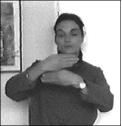
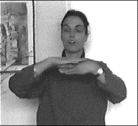
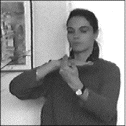
´wall´
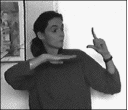
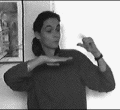
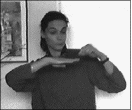
´bird lands on wall´
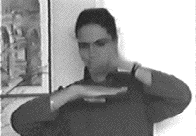
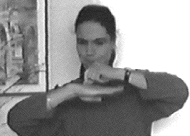
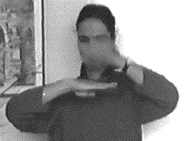
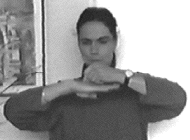
´bird pecks at bread on wall´
1. Rhythm in sign poetry: previous studies
2.1 Sign languages in oral environments
3. Movement structure: phonetics and phonology
3.2 The place of rhythm in movement structure
3.2.1 The long and short of it
3.2.2 Three aspects of movement structure
4. Paradox: movement as stasis
4.2 Wiggling and other oscillating movements: the case of SNOW
4.2.1 Short and long movements in poetic rhythm
4.2.1.1 Stanza-internal cohesion
4.2.1.2 Cohesion between stanzas
The work presented in Klima and Bellugi (1976, 1979) appears to be the first linguistic study which pays attention to the poetic function in sign language (specifically, ASL). The authors present various aspects of poetic form in the visual-manual mode and pay particular attention to the way transitions between signs are manipulated to obtain a continuous flow of movement and how a rhythmic superstructure is constructed on the basis of the regularity in the duration of signs and on the presence of accents. Their work accords with the intuitions of signers, who mention fluidity when they are asked about what characterises a signed sequence as poetic.
Now, if we take into account a specific poetic genre, rhymes addressed to children, we notice that most of them are constructed upon a strong rhythmic pattern. Since rhythm implies counting, we intend to show in this paper that the signing stream in poetic discourse can be perceived and segmented into discrete units composed of movements (and movement endpoints), that some of these movements are more salient than others and that the relative duration between points of prominence is both regular and contrastive.
We will further argue that based on these alternations between series of long and short sequences, a rhythmic pattern is constructed and several questions relevant for phonology can be asked, based on the contrast between observed structures at the phonetic and prosodic levels. Although movement plays an important role in the poetic context, this does not necessarily imply that movement is a distinctive unit in an ideal phonological representation of the syllable. (It can still be maintained that it is the surface realisation of a transition between two target positions.) We will argue that some movements — such as change of handshape or orientation, transitional movement and non-manual movement — can play an important role in poetic structure.
We will examine to what extent the study of poetry may contribute to our understanding of phonological structure or may, in contrast, present a structure that is largely deviant in phonological terms. For example, depending on whether an oscillating movement is considered to be phonologically atomic or, instead, divisible into smaller constituents, a different representation of syllabic structure results. Similarly , when non-manual movement is the only element that carries forward rhythmic structure in the signing stream, is it relevant at the phonological level or is it instead a phenomenon that can be compared with melody in oral nursery rhymes? A further crucial observation is the fact that poetry is not a succession of citation forms: transitional movement plays a crucial role in the rhythmic pattern. We address the question of whether these various aspects are linked only to performance (phonetic realization), or are instead the surface realisations of modifications at a deeper level of phonological structure.
The only traces we have of deaf poetry from the 19th century are in the form of written productions by deaf writers in French1 , English, and other oral languages. Obviously, there are no videotaped records of artistic expression in signs from before the second half of the 20th century2 . In the seventies, the burgeoning of cultural expression within the deaf community, especially in France and in the USA, has brought to light artistic expression in the form of poems and stage performance. Much of the literature on deaf poetry deals with common themes such as deaf identity, perceptions of the world, feelings of loneliness etc.3 but few studies have been devoted to the formal description of poetry in sign languages. Delving into the question of the relation between phonology and poetry provides us with an opportunity for reviewing earlier studies on the structure of signed poetry (most of them for American Sign Language) and for reformulating the kinds of questions usually posed in phonology from the perspective of poetic structure. In this paper, we will not attempt to deal with all of the "key characteristics that differentiate poetic from conversational usage" surveyed by Ormsby (1995: 220) but will focus instead on those aspects that more directly concern rhythmic structure, as it seems to us that rhythm plays a crucial role in poetic structure, and especially so in poetry addressed to children. As a result, our discussion inevitably confronts the issue of the phonological status of movement and its connection with rhythmic structure, questions that are currently the subject of much interest.
One of the first studies4 dealing with poetry in sign languages, Klima & Bellugi (1976), dates from the first flowering of research into signed languages, a decade and a half after the seminal study of Stokoe (1960). Klima and Bellugi examine characteristics of what they term "heightened uses of language" in American Sign Language (ASL): plays on words and art forms, and more specifically the sign counterpart of oral and written poetry, which they call "art-sign"5 . Among the various features of poetic structure they examine, they pay particular attention to the formal structure of signs and to the way their arrangement deviates from ordinary signing. Of their observations, those that particularly interest us are those concerning rhythm.
In order to create and to maintain "a flow of movement between signs," according to Klima & Bellugi, (p.59), the signer imposes "distortions [...] on the form of the signs themselves," "[...] but also (manipulates) transitions between signs" (p.65): he may select signs with the same handshape or modify the handshape of one sign so that consecutive signs have similar handshape, and furthermore he may see to it that the initial position of a sign is the same as the final position of the previous sign so that the transitional movement reduces or even disappears. While manipulations that consist of changes to the order of signs have counterparts in the oral modality, those that involve distortions to the form of signs and the reduction of transitions between signs have no clear analogue in oral language poetry. In rhythmic terms, signs are chosen partly in accordance with phonological criteria, moreover, some of these modifications, like change of handshape, may affect the phonological structure of signs when meaning is added or modified as a consequence of the change in form6 , and finally, some of the transformations violate rules governing phonological well-formedness in signs7 .
But in many cases, if a poetic version of a sign were replaced with an "everyday signing" version, the lexical and propositional meaning would not change, but the overall feeling and perception of the poem, that is to say, a less concrete kind of meaning, more metaphorical in nature, would. The fact that such changes do not affect the lexical meaning of signs, coupled with the fact that they are unlike other, regularly observed phonological processes, lead us to conclude that the kinds of changes in form observed in poetic signing should not be interpreted simply as phonological distortions. Rather, these changes should be interpreted as a merging of (certain features of) the signs´ form with other iconically or metaphorically motivated elements of form whose meaning is not ultimately lexical in nature. Many of these changes in form are in fact due to linguistic (i.e. phonological) structure being combined with mime-like gesture and a superimposed spatial and/or rhythmic structure, the product being a heightened use of language. In many cases, such changes could be profitably treated as analogous to the types of changes found in music, where the regular rhythmic structure, pitch and intonational contours of words and phrases are routinely distorted to fit in with the musical structure of the superimposed melody, whose form often metaphorically evokes meaning of a kind that goes beyond that of the lyrics alone.
Superimposed on the poetic structure discussed in 1.1, a "kinetic" and "rhythmic superstructure" is brought to light by Klima and Bellugi in some of the poems they examine: the former corresponds to "an enlarged pattern of movement" (p.68) and the latter to a rhythmic pattern based on accents, length of signs, and variations in speed and pausing. Both are compared by the authors to the melodic structure of songs in oral languages but it is worth noting that each of these processes is mentioned only in connection with one or the other of the signers (Bragg for kinetic superstructure and Miles for rhythmic superstructure). Making signs with a larger movement in poetic signing than in everyday "prose" signing seems to be a widespread practice since it is mentioned in other studies such as Moody (1983: 158). The consequence in poetic signing is that the delivery of signs is slowed down and becomes more fluid. As for the rhythmic pattern, Klima and Bellugi observe that the three ´lines´ in Miles´ rendition of her poem "SUMMER" are of equal duration and that they "each show a pattern of four accents" (p. 80). However, there is little explanation of what is considered to be an accent and what is a line in gestural mode, and, as Ormsby (p. 146) notes, "[the] "cadenced chants and cheers" in ASL that Klima and Bellugi mention as a source material [...] exhibit strict rhythmic structure, but no scansion is made of these, nor is the rhythm treated in any other poem they discuss. And regardless, adequate exploration of rhythm in artistic ASL still awaits advance in the general prosodic theory of sign."
The specific goal of Valli (1990) is to describe "the nature of a line in ASL poetry." His analysis is based on the segmental notation developed by Liddell (1984) and Liddell and Johnson (1985). In the Liddell and Johnson system, signs are analysed into movements (M) and holds (H). An M is defined as the period of time during which there is a change between handshapes, orientations or locations, and an H as the period of time during a sign´s articulation in which no such change takes place. "Local" movements such as finger wiggling and (trilled) change of orientation or of handshape may occur simultaneously with an M or an H. Such details, along with specifications for nonmanual signals, movement contour and handshape, are specified in feature bundles that are linked, via autosegmental association lines, to the M and H segments. According to Valli, repetition of handshape, path movement or non manual signals (eye gaze, orientation of the body, facial expression) across several signs in a sequence are all possible manifestations of rhyme in a sign poem. A "line division is identified by looking at rhyming patterns and finding their repetition." (p. 174). For Valli, the repetition of any one, or more, of these elements over two lines indicates a kind of "line terminator" and creates what he terms "line division rhyme," which is analogous to line-final rhyme in oral poetry.
Although it deals with several crucial questions such as segmentation of signs, repetition of features and segmentation of signing flow, it seems to us that this analysis is to some extent circular8 . First, it seems to us that the use of the Liddell and Johnson notation system, in which the temporal structure of signs is realised as M(ovement) and H(old) segments, does not sufficiently distinguish the variety of rhythmic structures in sign movements. As such, it does not account for the presence of certain rhythmic phenomena that are nonetheless of interest. We will attempt to show that an alternative temporal segmentation of signs into standard prosodic units such as mora, syllable, and foot is more useful for understanding the rhythmic structure of poetic signing. Secondly, it seems contradictory that repetition or reoccurrence of a feature is used, on the one hand, as a diagnostic for line cohesion (when for instance three consecutive signs have the same handshape), and on the other hand, as a diagnostic for line division (when for instance one finds a downward movement and the same kind of movement three signs later and the string from the first one to the second one is delimited as a line).
Although Valli draws an analogy between rhyme types involving line-internal repetition, such as alliteration and assonance, and their counterparts in ASL, it is not entirely clear from his argument how rhyming between lines is to be distinguished from line-internal rhyme. His analysis seems to draw no clear distinctions between handshape rhyme, path movement rhyme, non-manual rhyme and line division rhyme which would show that they are distinct phenomena. It seems, on the contrary, that line division rhyme ought to be defined on the basis of position and (partial) structural parallelism between lines whereas the first three types appear simply to be repetitions of phonological features (in a non-technical sense) that contribute to line-internal cohesion. In our view, the analysis presented by Valli would be more convincing if some other diagnostic for defining a line were shown to correlate with the features examined.
In conjunction with the above remarks, the examples presented do not seem to us to be as persuasive as they could perhaps be: in his first example (see (1)), Valli compares the movements of LEAVES-FALL and GRASS-WITHER, saying that "they are similar, both go downward," thus "the path movement rhyme functions as a line terminator" (p. 174). However, FULL-OF-LEAVES-IN-TREE-TOP also has a downward movement. In fact, if similarity across lines is to be taken as a marker of line division, (all other things being equal) FULL-OF-LEAVES-IN-TREE-TOP would be a better candidate for a line end marker given the form of its movement path and its rhythmic structure (which is not however recoverable from the form of the Liddell and Johnson notation used), these two being more similar to those of GRASS-WITHER than are those of LEAVES-FALL.
(1)
| TREE | FULL-OF-LEAVES-IN-TREE-TOP | LEAVES-FALL |
| GRASS | SLENDER-GRASS-WAVE | GRASS-WITHER |
As for the second example, the handshape and non-manual rhymes form another line terminator according to Valli, but it seems at least as valid to attribute the similarity to the fact that both segments concerned are the same sign, ETERNAL.
(2)
| TIME | HOUR | ETERNAL |
| SUN | FROM-SUNRISE-TO-SUNSET | ETERNAL |
We are in agreement with the proposal to divide sign language poems into lines, but we think, as mentioned above, that the following proposal would help to clarify our understanding of the formal nature of a line within a larger poetic structure: a line is characterised by homogeneity or regularity, i.e. some unifying internal motif, while a boundary between two lines is characterised by a break or contrast or, at least, by being an anchor point which permits detection of a structural parallel with another line. This break can be of any sort: signing rhythm, syntax, orientation of the body, hand alternation etc.; we will develop this proposal in the second section as we examine the structure of children´s poetry.
In the fifth section of his article, Valli (p. 174) suggests that further study of rhythm is needed, recalling elements that contribute to rhythmic structure, such as "various relations of long and short or accented and unaccented syllables, measured flow of words and phrases [...] stresses and pauses [...]." In connection with this, we can cite Neumann (1993), who describes phonological and morphological variations between poetic and citation form, among which she mentions changes in the movement paths of signs, a straight movement becoming a "7" movement for instance. Such modifications contribute to the movement path rhyme described by Valli, and we would add that they also affect the rhythmic structure of the signs affected.
Just as in oral languages, nursery rhymes exist in sign languages. They are part of language games, along with tongue-twisters, lullabies, riddles, and so on. As far as we know, they are created by deaf adults for children (while another type of lore is well known for oral languages: these are rhymes created by children themselves, but so far, no such children´s folklore seems to have been attested in deaf communities). For the study of poetry, nursery rhymes can be treated as a sort of magnifying glass that brings specific aspects of poetic structure into relief.
The language whose poetic forms we are analysing, LSF (French Sign Language), is not a (mythically) "pure" sign language, in other words one that has developed without undergoing any kind of influence from the oral language of the surrounding environment. It seems clear that LSF is unavoidably in contact with French and this sociolinguistic criterion must be taken into account for many reasons9 . As a result, it should be kept in mind that many nursery rhymes in our corpus are adaptations (but not translations) from those existing in the oral language, an inevitable consequence of living in an oral-centric environment, a fact pointed out to us by the authors/adapters themselves. It is interesting to note that in original nursery rhymes created in sign languages (as opposed to adaptations from oral languages), we find themes in common with those often developed in nursery lore in oral language, such as seasons, colours, days of the week, animals, the alphabet and numbers (See Arleo (1982), who surveys themes developed in French and Anglo-American children´s folklore). Hearing and deaf children share, in part, the same cultural heritage via themes and topics that appear in poetry; moreover, poetic processes are similar in both the oral and signed modes with respect to aspects such as repetition of features (described in Valli (1990), for instance, as equivalent to alliteration or assonance), creation of metaphors, and beat patterns, which are the central concern of this article.
In order to determine rhythm in oral children´s songs and chants, Arleo and Despringre in Despringre (1997: 27) suggest, as a procedure, to:
(3)
"(...) measure the reoccurrence of similar rhythmic groupings (...) in tandem with this, (to find) recurring stylistic patterns that give rise to these cycles (...) (to) isolate smaller units in the overall beat structure — units of length — on the basis of contrasts in length (e.g. long vs short) (...) (to) take into account, at the same time, recurrent accents associated with these units. " (Our translation)
Observation of rhythmic patterns in LSF nursery rhymes shows that they are usually based in part on the alternation of accented and unaccented elements. Rhythmic accent can be realised in a number of different ways and no single given feature found in an accented element is on its own either a necessary or sufficient indicator of accent10. We assume that the realisation of accent, as a poetic analogue of lexical, phrasal or emphatic stress, analysed by Wilbur and Schick (1987), is often (as they argue for linguistic stress) the result of a combination of features rather than being due to the presence of a specific feature. Most of the movements that we have observed to be connected with rhythmic accent follow a general downward direction (downward inclination of the head, adduction of the upper arm) or, more generally, seem to involve movement toward rather than away from an anatomically neutral position (inward angular rotation of the forearm, forearm pronation, or flexion of the hand at the wrist). Moreover, a rhythmic accent often corresponds to accelerated movement of an articulator (easily perceived on video since the image of the articulator blurs under acceleration). Finally, movements of the head and body, superimposed on the movements of signs themselves, play an important role in coding accentuation; this observation is reinforced by the work of Wilbur and Patschke (1998), who report that forward and backward leans of the body function prosodically to mark linguistic ´stress´. The combination of such non-manual movements with the movement of the signs themselves forms an overall pattern that leads us to us interpret a sign movement whose manual components, taken alone, appear unstressed or unaccented, as accented with respect to neighboring elements in a sequence. In summary, non manual articulators play an important role in building a rhythmic superstructure based on the alternation of accented and unaccented elements.
Determining the boundaries between lines is a subtle matter. There is no single definitive correlate of line boundaries: a line break can be identified with a discontinuity in syntactic, semantic or rhythmic structure, or with a combination of two or more of these. This can be illustrated by "La poule"11 , an LSF nursery rhyme in which the following sequences occur.



´wall´



´bird lands on wall´




´bird pecks at bread on wall´
The lines are delimited by correlations between, rhythm, syntax and information structure, as shown in the following table:
|
|
|
|
|
|
first
|
long sequences | constituent | background; topic+attributive |
| second | long sequences | constituent | foreground; topic+comment |
| third | short sequences | constituent | foreground; comment |
Table 1. Structural correlates of lines in the nursery rhyme "La poule"
The rhythmic structures alluded to in the preceding paragraphs are bound up with the question of the phonological status of movement, since stress and the dynamic structure of movement are inextricably related: the notions of acceleration, contact, change of orientation etc. inevitably imply movement on the part of some set of articulators.
To illustrate the relation between rhythm and movement structure, we will take an example of a poem created by children: the instruction given by their deaf teacher12 was to tell a short story about a walk in the countryside, using the same /5/ handshape![]() throughout. The beginning of the poem is made up of the following signs :
throughout. The beginning of the poem is made up of the following signs :

As can be seen in the transcription, this first stanza is composed of four lines, each of which contains two signs and begins with the sign WALK. Observation of the rhythmic shape of the second sign in each line reveals the following pattern: the second sign in the odd-numbered (first and third) lines, (SEA and COUNTRY, respectively) contains a repeated long movement, like WALK, whereas in the even-numbered (second and fourth) lines, the second sign contains a repeated short movement (i.e. secondary movement or oscillated local movement). In other words, the structure of rhythmic alternations between signs in the first and second lines is repeated in the third and fourth lines, giving an overall structure (1) ab ab, (2) ab ac, (3) ab ab, and (4) ab ac. The illustrations reproduced below give a static impression of the rhythmic structure of the signs MOUNTAIN and COUNTRY.
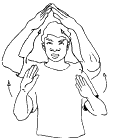 |
 |
|
|
MOUNTAIN |
COUNTRY |
Similar observations can be made with respect to the rest of the poem, whose rhythmic structure is transcribed in whole at the end of this article. Each stanza is characterised by a grouping of lines, which share similar structure among themselves. In general, this similar structure is based on the rhythmic structure of pairs of signs that together make up a line, but the line structure of certain stanzas (namely the second and the fourth) is also based on an alternation between the left and right sides of the signing space. We return to these questions in later sections, but we will first discuss in greater detail the view of movement structure that we adopt in this paper, as it differs in significant ways from other approaches in the literature and it is the very differences in this approach that result in its being particularly well adapted to. poetic analysis, in our view.
Up to this point, we have generally referred to movements using a descriptive vocabulary that is widely used in the literature on the phonology of signed languages. The general consensus is that there are two types of movement: path movement, describable in terms of direction and contour, which is considered to be the "primary" or most typical exemplar of sign movement, and non-path or "local" movement, which is considered (by most researchers) to be in general "secondary" in its phonological functions with respect to path movement. Secondary movements may co-occur either with path movements or with non-movement segments of the signing stream and are generally treated in a manner analogous to secondary articulations on consonants in oral languages, such as palatalisation or labialisation.
Miller (1997) presents a rather different view of the relation between path-forming and local or non-path-forming movements. In this model, which we adopt here, the widespread existence of derivational relationships between signs with path and non-path movements performed by the same articulators is taken to argue for their essential identity. Miller argues that the essential distinction between the two types of movement is in fact one of phonological length. It has long been observed that the fundamental distinction between the two types of movement lies in a combination of relative length and repetition. Whereas path movements are relatively long in duration and are typically not repeated unless lexically specified to do so, non-path "secondary" movements are, almost without exception, typically performed with multiple repetitions and each cycle of the movement is short in duration. However, while other models do not isolate the multiple cycles of secondary movement as phonologically autonomous units, Miller argues that each such cycle in fact makes up a single short (monomoraic) phonological syllable, which contrasts paradigmatically with a long (bimoraic) counterpart.
Two kinds of evidence point toward this conclusion. Firstly, the syllabic status of each (short or long) movement cycle is motivated by the existence of well-formedness constraints that generally disallow certain kinds of handshapes or contacts in movement/syllable-initial or final positions and of similar constraints that are more restrictive for short/local movements than for long/path movements. This seems to be clear evidence that each cycle of a short, oscillating movement is in fact a phonological constituent similar in status to a long movement, in other words a syllable. This view contrasts markedly with the consensus view of secondary movements. The latter view holds them to be unanalysable or uncountable rapid repetitions of a base cycle. As such, the base cycle of the movement is held to have no phonological status: it is only the complete oscillated movement that is treated as a phonological entity. In striking contrast with the view we adopt here, a complete sequence of oscillations is represented under the standard approach as a phonological feature, that is to say the most fundamental — and thus inherently unanalysable — unit of phonological structure. It is therefore impossible within such a framework to represent any phenomena that have as their domain anything smaller than the oscillated sequence as a whole.
The second kind of evidence that points toward a segmentation of "secondary" movements into sequences of short syllables is based on syntagmatic, rather than paradigmatic, phonological relations. Recall that the standard consensus view holds oscillating, "secondary" movements to be unanalysable wholes in which the number of repetitions of the base cycle is uncountable or, at least, if countable, without any phonological significance. The fundamental observation behind this view cannot be challenged: it is true that the number of iterations of the base movement is highly variable. For example, the range of numbers of executions of a base movement in LSQ is observed to vary between one, two and three at the low end and eighteen or more at the high end. This does not mean, however, that it is unpredictable. It turns out that the number of possible repetitions is sensitive to the surrounding phrasal and discourse context.
The high end of variability occurs only in certain types of contexts where a sign is not phrase internal: these typically involve signs produced in isolation or utterance final signs that undergo sustained repetitions as a means of signalling, in the context of some kind of interruption to the signer´s discourse, that the signer has not relinquished the floor. Otherwise, the number of cycles is typically one (i.e. without repetition) or two phrase-internally, and two, more typically three, and less often four, phrase finally. The greater number of repetitions in phrase-final position appears to be the result of a more general phenomenon that also affects lexically repeated long movements. Most interesting for the purposes of this discussion is the fact that repetition or nonrepetition of the base cycle of a short movement is sensitive to the foot structure of the phrase in which it is embedded. If a short movement sign, i.e. one lexically represented as a monomoraic syllable, is able to form a foot with the immediately following (first) syllable of the next sign, it surfaces without repetition. If, on the other hand, it is prevented from forming a foot with a following syllable, usually because an overheavy foot would result or because of an intervening syntactic boundary, the short syllable is repeated in order for the sign to form a foot by itself.
This analysis of oscillating movements as (sequences of) monomoraic syllables has clear consequences for the analysis of poetry. Whereas such movements must be treated as unanalysable wholes in treatments of poetic structure that rely on the current consensus view of movement structure, the model adopted here requires that each cycle of an oscillating movement be treated as a separate short syllable that contributes independently to the rhythmic structure of the verse in which it occurs. Numerous analyses of poetic corpora will be needed to distinguish the strengths and weaknesses of each approach, but we believe that the analyses we present in this paper give reason to support a syllable-based approach to oscillating movements.
The analysis of short versus long movements presented in Miller (1997) is dependent on an overarching conception of the nature of movement as formed of three autonomous, co-occurring and complementary types of structure. Movement can be analysed in terms of the spatial contours that movement paths trace, the directions in which they are traced and the imaginary planes on which the movement paths are described. This is the geometrical aspect of movement structure. Movement can also be conceived as the superficial result of sequences of states traversed by the articulators involved. This is the articulatory/sequential aspect of movement structure. Finally, movements that are otherwise similar in terms of their geometrical and articulatory/sequential structure can be differentiated on the basis of their duration and other dynamic aspects of their structure, such as changes in velocity or periodicity of a movement. This is the temporal aspect of movement structure.
Each of these aspects of the form of movement plays a distinct role in the grammatical structure of a sign language. However, Miller (1997) argues that only the articulatory/sequential and temporal aspects of movement play any clear role in the phonology of a sign language. This is because (a) proposed phonological features that characterise global aspects of a sign´s form, whether its overall dynamic structure (e.g. a feature such as [oscillating]) or its geometrical structure (e.g. [arc]), do not behave like other phonological features in contexts that would seem to encourage sequential feature assimilation between signs or between members of complex or compound signs, and (b) all path contours and directions, usually described by means of features, can be reduced to sequences of specifications for states of the articulators, thus obviating the need for an additional level of structure.
The overall conception of movement as a phonological construct, then, is that of a sequence of states of the articulators (manual and/or nonmanual) which is organised in time by virtue of being dominated by, and included in, the universal domains of prosodic structure, namely the mora, the syllable, the foot, and higher constituents. This does not imply, however, that the apparent absence of a phonological role for geometrical structure means that it plays no role at all in the grammar of a sign language. It seems clear that the form and the direction of sign movement play a significant role in a sign´s morphological structure at the interface between its iconic or metaphorical motivation and and its phonological form.
It is by analysing movements into sequences of states of the articulators that it is possible to motivate the existence of syllables with contrastive length, and by attributing to moras, syllables and higher units of the prosodic hierarchy the role of determining the temporal structure of movement, that we are able to analyse the rhythmic structure of sign poetry in terms that allow them to be compared with analyses of oral language poetry. In the following sections of this article, we will present analyses that clearly illustrate the rhythmic structure of signed poetry, allowing us to use it as a basis for determining a poem´s macrostructure in terms of lines and stanzas.
In the previous section we reviewed different approaches to the phonological status of movement and explained why we consider movement, as a phonological phenomenon, to be a phonetic transition between two (or more) phonological target points. In the following section, we intend to raise a number of issues concerning movement that emerge from the study of poetic structure which may offer new perspectives for phonology of sign languages in a broad sense.
There are two kinds of transitional movement: internal transitions are those found inside a repeated unidirectional movement.
(4a)
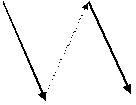 |
Versus bi-directional movement:
(4b)
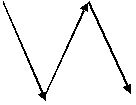 |
The transitional movement symbolised by the dotted line in (4a) is the articulatory-level consequence of the transfer of the hand from the end point of the first arrow to the starting point of the third arrow. The first and third movements have the same degree of muscular tension, while the transition is less tense. In (4b) the three movements have an equal degree of tension. This type of repetition of a movement with an intervening transitional movement is described as follows by Allen, Wilbur and Schick (1991: 301):
(5)
Lexical items with more than two syllables arise from reduplicated monosyllables that have been frozen; this usually results in a three syllable form with the third syllable a repetition of the first, and the second syllable a transition syllable between the first and second lexical movement [...]. In such cases, there is an alternating accent pattern, with accent on the first and third syllables and no accent on the transition syllable in the middle.
A second type of transitional movement is external. This type of transition is the simple transition of the articulators between two different signs when the end position of the first sign is different from the initial position of the following sign.
The majority of phonological studies, including those using lexical databases, such as Bonucci (1997) or van der Hulst (1993), analyse only the citation forms of signs, and thus typically do not take into account transitional movements, at least those between signs. It seems uncontroversial that at the lexical level, at the very least, such external transitions play no phonological role, as evidenced by the following quote from van der Hulst (1993: 235):
(6)
"Of course, there are transitions between sign rhymes, i.e. movements from one sign to another. Such movements, which must be sharply distinguished from path movements (...), could be referred to as ´onsets´, but unlike onsets in spoken languages, they do not have distinctive properties. (...) The fact that these ´onsets´ in sign language lack distinctive properties places them outside the realm of phonology."
In poetry, such transitional movements are exploited in many different ways, unlike in everyday signing. We saw in section (1.1) that these movements are often reduced but they can also be conserved or even reinforced and can be integrated into a rhythmic pattern. Klima and Bellugi (1976: 92) give an example where muscle tension is maintained throughout the transition and they further evoke "creation of structured effects – of patterns – through manipulation of what are otherwise ´incidental´ aspects of the act of signing" (p. 95).
The question is which level of the analysis is affected by these modifications. In other words does the way transitional movements are treated in poetry modify the phonological or prosodic structure of the sign? We would be inclined to believe that when transitional movements are simply maintained and reduced to fit into the stress pattern, signs are not affected in their phonological structure. When the transition is stressed or otherwise exaggerated, though, we are faced with the fact that we are dealing with an exceptional variety of phonological structure where transitional movements are treated in a manner similar to lexical movements in core phonology. This exceptional phonology might be seen as occupying one end of a continuum, the other end of which is occupied by conversational signing. Under this view of things, each linguistic register along the continuum has associated with it a particular set of grammatical structures and phenomena, including those that are specifically phonological in nature. This hypothesis garners some support from Ormsby (1995: 177), who observes that "certain standard phonological processes such as assimilation are checked more scrupulously in formal and poetic signing than in other varieties.13 "
As discussed above, the consensus view is that there exists a fundamental distinction in phonology between what are termed "primary" and "secondary" movements. For example, Van der Hulst (1993: 216-217) reviews different types of movements and distinguishes on the one hand primary movements comprising path movement ("involving one place and two settings") or local movement (including aperture change and orientation change) and on the other, secondary movements ("rapidly repeated activity"). Most treatments consider such "secondary" movements to be unanalysable wholes, represented by atomic features. For the purposes of poetic analysis, the implication is that any rhythmic structure internal to these movements should have no implications for poetic structure as such. In our analysis, however, each cycle of the oscillated movement forms a (short) syllable by itself and each such syllable must therefore, we assume, inevitably play a role in a poem´s rhythmic structure.
There are a number of identical or similarly formed signs that we find in nursery rhymes from many different sign languages. These signs are linked with the idea of water falling or scattering, with ´rain´, ´snow´ etc., and they are found in nursery rhymes in NGT, LSQ and LSF14 if not in other signed languages as well. They fit in with the seasonal theme that we mentioned in section (2.1), and are articulated with a wiggling movement of the fingers, considered a type of "local" or "secondary" movement by many authors.
One example of this sign occurs in the poem "A walk in the woods," which we have transcribed in full at the end of this article. Compared to other oscillating movements, finger wiggling appears anomalous in that superficially, its form does not correspond directly to that of any long movement involving handshape change. However, when we examine the derivational relations between wiggling movements and others, we discover that its origin can be found in sequences in which a closed hand, unrestrained by the thumb, opens to a /5/ handshape. However, there is a paradigmatic gap for this type of opening movement: we never find this kind of opening sequence (without initial restraint) in a short syllable. It turns out, in fact, that this gap is filled by a wiggling /5/ handshape. An example of this is a modern ASL and LSQ variant of the signs MOTHER and FATHER, in which the fingers of the open /5/ hand wiggle, the thumb being in constant contact with the chin or the temple, respectively: earlier variants of these signs (still extant but with limited distribution in LSQ) actually show a single opening sequence from an /A´/ handshape (thumb extended) to a /5/ handshape.
Although it seems that the wiggling /5/ handshape is (often) a phonetic level reinterpretation of an opening to /5/ sequence — in many cases, of course, it directly iconically motivated —, it remains that its rhythmic structure is different from that of other oscillating short movements. Whereas in these other movements the transition between the end of one cycle and the beginning of the next seems to bear no weight, a wiggling movement cycle is clearly divided into two parts. The first part involves flexion of the body of the middle and ring fingers and, optionally, the pinky, with concomitant extension of the index; the second part involves flexion of the body of the index with concomitant extension of the other fingers. It is difficult to detect any difference in relative weight between the two halves of the cycle; for this reason, we treat each as a single monomoraic (short) syllable. This type of structure is much more reminiscent of certain oscillated bidirectional twisting movements of the forearm, such as we find in the sign MOUNTAIN in "A walk in the woods," reproduced below.
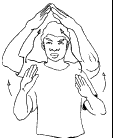

MOUNTAIN
In the poem "A walk in the woods," alternations between long and short movements play a significant role at two levels. At one level, they serve to set up contrasts and similarities between pairs of lines within a stanza. This occurs in the first and the fifth (and last) stanza of the poem. At a second level, they serve to set up a parallelism between stanzas that contributes to the structural cohesion of the poem at a higher level.
The first and last stanzas of the poem are both made up of four two-sign lines, which further subgroup into pairs (7a, 7b). Within each pair of lines, there is a rhythmic contrast between the final signs: one has long movements and the other has short movements. This gives an overall rhythmic structure of L L / L S for the line pair, where L represents a sign with repeated long movements and S a sign with repeated short movements. The two pairs of lines, when compared, show a structural parallel: in the first stanza, the structure is (L L/L S) (L L/L S); in the final stanza, the order is reversed, reflecting the overall end-to-end rhythmic symmetry of the poem.
(7a) First stanza

(7b) Last stanza

The overall rhythmic structure of these two stanzas is thus based on the repetition of a two-line unit in which the final signs alternate between long and short movements.
Whereas an alternation between short and long movements contributes to internal cohesion in the first and last stanzas, it is used to build cohesion between stanzas two and four, which we reproduce in (8), separated by the third stanza.
(8)
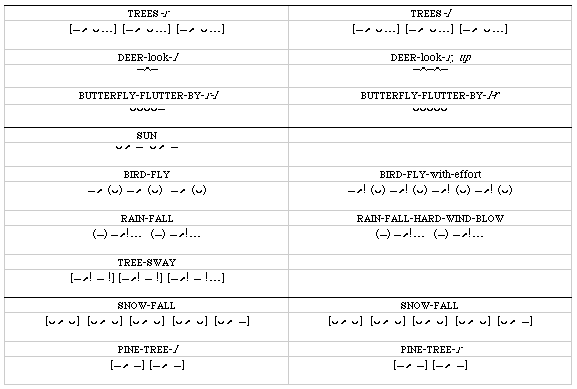
In the preceding paragraphs we alluded to an overall end-to-end symmetry in the poem´s rhythmic structure. This symmetry in structure is centred on the break between the second and third lines of the middle (third) stanza. The peculiar structure of this particular stanza serves to clearly illustrate the axis around which the symmetry is constructed. The second and third lines (BIRD-FLY, BIRD-FLY-with-effort and RAIN-FALL, RAIN-FALL-HARD-WIND-BLOW), which immediately precede and follow the break, contain the same kind of structure. In each line, the same sign is produced twice, but with greater force and emphasis and with the addition of expressive nonmanuals in the second part of the line. On either side of these two lines, i.e. in the first and fourth lines of the stanza, we find a line type that is found nowhere else in the poem. Each of these lines is formed by a single sign, which is furthermore one-handed, unlike almost all other signs in the poem: SUN and TREE-SWAY. Thus the order of the second line pair in this stanza is clearly inverted with respect to the first. This pattern repeats itself: as we simultaneously move backward line by line, stanza by stanza and at the same time forward line by line, stanza by stanza, we find similar structures but with inverse orders, mirroring each other around the break between the two middle lines of the third stanza.
This brings us to the structural symmetry between the second and fourth stanzas. At first glance, these two are less comparable than are the first and fifth stanzas. Most strikingly, the second stanza has three lines whereas the fourth only has two. Digging deeper, though, we find that there do exist a number of parallels. One of these has to do with the use of space. Each of the three lines in the second stanza involves an alternation between the left and right hand sides of the signing space, the first half of a line using one side and the second half using the opposite side. We find the same kind of alternation in the fourth stanza, though in the last line only. More importantly, despite the relative weakness of the symmetry at this point, these are the only two stanzas that do show any kind of left-right alternation.
At the level of rhythmic structure, we do in fact find the same kind of temporal symmetry around the central line break as elsewhere although, again, it is not as clearly implemented as in the first and fifth stanzas or within the middle stanza. The main difference between the two stanzas is that the second stanza contains a second line consisting essentially of a smooth chain of nonmanual movements. These movements together form a continuous glide within which (smooth) transitions between shorter sub-movements are nonetheless easily identified. In terms of its rhythmic structure, then, this line falls somewhat outside the regular, cadenced sequences of distinctly bounded syllables that are found elsewhere in the poem.
If we exclude this line as extraneous to the cadenced rhythmic framework of the poem, the second and fourth stanzas appear much more similar in structure. What we observe now is a pair of lines, one of which contains a sign with long movements, performed twice, and a sign with short movements, also performed twice. Furthermore, in the second stanza, the L movement line precedes the S movement line, whereas the order is reversed in the fourth stanza.
Interestingly, the first line of the second stanza contains the sign TREES, which is normally made with a repeated short twisting movement of the forearm. In this version of the sign, however, the movement is noticeably slowed down and is much crisper than in the normal version of the sign. In particular, in each pair of complementary rotations of the forearm, the second ends in a hold before the cycle starts again. This movement is mirrored by the movement of PINE-TREE in the second line of the fourth stanza. In this sign, each of the two feet contains two movements in complementary directions (which trace the outline of an idealised pine tree), thus mirroring to some extent the movement structure of TREE in the second stanza.
The third line of the second stanza contains two instances of the sign BUTTERFLY-FLUTTER-BY. This sign is composed of repeated short bending movements of the fingers. In the first half of the line, there are four iterations followed by a hold as the hands as a whole glide downward a short distance, making effectively for five movements; in the second half, there are five short beats. In this sign, since the transitional return movement is so brief as to be unnoticeable, we have not noted it at all.
The structure of BUTTERFLY-FLUTTER-BY is mirrored by that of SNOW-FALL in the first line of the fourth stanza. As we argue above, the finger-wiggling movement in this sign is a short movement comparable to others that have long movement equivalents. However, since wiggling always involves bidirectional movement of the fingers, we are forced to attribute a syllable to each, which gives us five pairs of syllables (in other words, five feet) for each of the two occurrences of SNOW-FALL. The parallel we are able to draw between this line and the last line of the second stanza is thus not exact: we are comparing feet in one with syllables in the other. It must be said that the rhythmic status of each part of the two-part cycle in wiggling movement is not fully clear yet: research on the comparative behaviour of wiggles and other short movements in phrasal phonology remains to be done. Nonetheless, the poem seems to provide some evidence for considering that despite the superficial differences in rhythm, these two types of short movement are treated as underlyingly similar.
In this section we address the issue of the boundary between linguistic gesture and non-linguistic gesture, especially in poetry aimed at children, since we know that the analysis of the connection between words and gesture is particularly rich for the rhythmic structure of nursery rhymes in spoken language (see Despringre 1997). We have observed only one language game, involving hand clapping, and two others adapted from rounds in which signs alternated with dance steps. It might seem to make sense that if the hands are being used for linguistic purposes they would not be involved in a non-linguistic process at the same time.
On the other hand, the place of non-manual articulators in the grammars of sign languages has still not been fully explored, although some aspects of their roles are more or less well described (question and topic markers, for instance); moreover, the boundary between grammatical and expressive function is not easy to determine and the suprasegmental role of these non-manual signals needs further study.
It is clear however that certain classes of sign exist, at least in LSQ and ASL (Dively 1998, Dubuisson 1999), which are composed solely of nonmanual behaviours and in LSQ at least, many signs inflected for aspect realise the rhythmic structure associated with the aspectual form by nonmanual means rather than by modifying in detail the rhythmic structure of the affected sign (Miller 1997). It thus is not unexpected that nonmanual movements may play a role in poetic rhythm.
In section 4.2.1.2, we discussed the presence of the nonmanual signs DEER-look-l and DEER-look-r, up in the context of the overall rhythmic structure of the poem and concluded that despite their presence in the second line of the second stanza, they were extraneous to the rhythm of the poem as a whole. In this context, the stanza´s second line can be treated as a sort of phonologically realised pause which, although it shares some of the temporal and spatial structure of the other two lines, is in a manner of speaking "opaque" to the computation of the poem´s overall rhythm15 . Nonetheless, this pair of signs clearly fits in with the overall structure of the second stanza, which we reproduce in (9).
(9)

The only manual sign in the third line is DEER, which is made with both hands, placed on the head, with the ´5´ handshape ![]() and a contact between the thumb and the forehead. Forming the sign itself accounts only for a single long movement in the line´s overall structure, however. The rest of the movement structure is made up of two long glides in opposite directions. The first glide follows directly on DEER. Holding her hands in position, the signer moves her torso from the centre to her left, thus forming a nonlexical, nonmanual predicate DEER-look-l. The second glide, from her left side to her right, is composed of three smoothly connected submovements (DEER-look-r, up, illustrated in (10)). The first is a slightly downward sweeping movement of the trunk from the signer´s left to the centre, followed smoothly by an upward return to the signer´s right which, when completed, is followed by an upward movement of the eyes, accompanied by a slight complementary movement of the trunk and the head.
and a contact between the thumb and the forehead. Forming the sign itself accounts only for a single long movement in the line´s overall structure, however. The rest of the movement structure is made up of two long glides in opposite directions. The first glide follows directly on DEER. Holding her hands in position, the signer moves her torso from the centre to her left, thus forming a nonlexical, nonmanual predicate DEER-look-l. The second glide, from her left side to her right, is composed of three smoothly connected submovements (DEER-look-r, up, illustrated in (10)). The first is a slightly downward sweeping movement of the trunk from the signer´s left to the centre, followed smoothly by an upward return to the signer´s right which, when completed, is followed by an upward movement of the eyes, accompanied by a slight complementary movement of the trunk and the head.
(10)
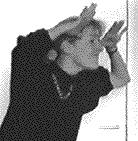
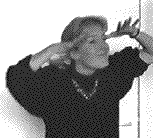
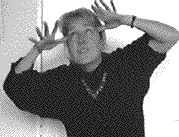
DEER -look-r, up
In terms of the overall structure of the second stanza, this line is entirely consistent with the first and third lines with their entirely manual signs. The two sweeping movements, one to the left, the other to the right, fit in with the overall right/left alternations in the other two lines. Beyond this, though, and despite the fact that this line does not "fit in" with the overall rhythmic structure of the poem, it contains an interesting parallel with the movement structure of the third line. Where the first half of the second line is subdivided into two movement syllables, the second half contains three with the addition of the final movement where the deer looks upward. Similarly, the first execution of BUTTERFLY-FLUTTER-BY contains four short syllables corresponding to a single bending movement of the fingers, which are followed by a hold of the final bent handshape in which the hands glide downward a short distance. In contrast, the second execution of the sign contains, with the addition of an extra final movement, five full short syllables. The structural parallelism between the two lines, in which the second occurrence of a sign has an extra movement syllable (irrespective of its length or the articulators involved), gives an overall effect of anticipated action followed by completion that would not be apparent if the second line were not present. Despite its apparent irrelevance for the poem´s overall rhythmic schema, the second line of the third stanza nonetheless plays a significant role in the computation of stanza-internal rhythmic structure, contributing to an effect of anticipation and thus providing a slight note of tension before the third stanza — quite literally, or rather literarily, the calm before the storm.
Our overall aim in this article has been to explore the ways in which the study of poetry can shed light on phonological theory. It would certainly be beyond the scope of this investigation to explore the insights that poetry can provide for any large range of theoretical constructs. We have, however, been able to demonstrate in our discussion that a particular model of the rhythmic structure of movement, namely that proposed in Miller (1997), is up to the task of accounting for some interesting aspects of the overall rhythmic structure of one particular poem in sign language. Obviously, as is true for any theory, each new set of data — in this case, each new poem with its own peculiarities — constitutes a new test of the theory´s robustness. The explanatory power of this theory thus remains to be tested against as much data as possible, poetic and non-poetic, before its strengths and weaknesses relative to other phonological models become clearly apparent.
Keeping this in mind, we would like to tentatively apply the type of analysis we have done here on "A walk in the woods" to the two lines of Valli´s poem "SNOWFLAKE" that were discussed in section 1.2.
Reviewing Valli´s analysis of line structure in "SNOWFLAKE," we observed that the M(ovement)-H(old) notation system he uses (Johnson and Liddell 1985), while effectively representing many aspects of the structure of the signs in the poem, does not seem to account very well for the rhythmic structure of the verses illustrated. In fact, information on the rhythmic structure of the two lines was more easily gleaned from the illustrations provided than from the form of the M-H notation itself. Since the basic claim of the M-H model is that sequences of movements and holds make up the fundamental segmental structure of sign sequences, one might expect that a particular sequence of M and H segments would in some way reflect the rhythmic structure of the string of signs. However, the M-H sequences Valli that appear in Valli´s notation, reproduced here in (11) with extraneous information excluded, do not seem to exhibit any kind of structural parallels across lines, in contrast with the other types of parallels that Valli discusses.
(11)
|
|
|
|
|
|
|
|
|
|
|
´GRASS-WITHER´ |
|
|
|
|
There are two possible conclusions : either rhythmic structure simply does not play any role in this line sequence, or the notation used excludes the possibility of representing what structure may be present in the signal. Observing the otherwise unavailable information provided in the accompanying drawings, we adopt the second hypothesis. In order to verify whether the missing information contributes to building any rhythmic structure across the two lines, we transcribed each observed movement by length according to the rhythmic analysis of movement structure in Miller (1997). The resulting transcription appears in (12). Although we suspect that both LEAVES-FALL and GRASS are made up of short rather than long movements, since no other relevant information appears in Valli´s transcription or illustrations, we transcribe them as long here.
(12)

The final result, though not perfectly clear, shows much more regularity of rhythmic structure than the M-H notation. In fact, it appears that the two lines are temporally symmetrical, much like the poem "A walk in the woods" analysed earlier in this paper. We enclose the final four movements of LEAVES-FALL between parentheses to emphasise that the extra repetitions are a predictable consequence of phrase-final position for a sign specified for repeated movement, as Miller (1997) observes. Treating these extra repetitions as a superficial phenomenon brings out the overall rhythmic symmetry quite clearly. If in fact, as we suspect, the movements of LEAVES-FALL and GRASS are made up of short rather than long movements, the presence of short movements at opposite ends of the two lines would only serve to reinforce the pattern that appears. In the absence of the primary data, we can only surmise the exact rhythmic structure of the line pair presented by Valli, but it does seem clear that the prosodic model of rhythmic structure argued for in Miller (1997) yields a much more explanatory and interesting representation than does a M-H model of sequential structure.
Returning to "A walk in the woods," we think it worthwhile to summarise our analysis in graphic form, bringing together several aspects of the poem´s structure in one place, including the thematic structure, which correlates well with the division into lines and stanzas established on rhythmic grounds. We illustrate this structure in Table 2.
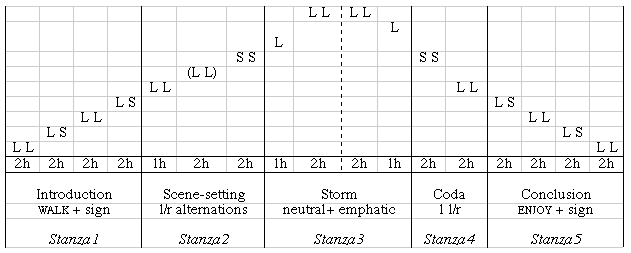
Table 2. Structural and thematic correlations in "A walk in the woods."
Table 2 summarises the overall structural characteristics of the poem by aligning different types of information in linear and columnar form. The central line break, around which the poem´s structure organises itself in a temporally symmetrical form, is indicated by a dashed line. Boundaries between stanzas are indicated by solid lines. The symmetry in movement structure between lines (except for the non-manual line, enclosed in parentheses) is illustrated by aligning corresponding pairs of lines in descending order by increasing distance from the central line break: the letter L indicates a sign composed of long syllables; the letter S indicates a sign composed of short syllables. For each line, the number of hands involved in articulating the relevant signs is indicated below the indications of length. Below this line, the thematic structure of the five stanzas is indicated, followed on the next line by the structural motif typical of the stanza: here, the parallelism around the central stanza reveals itself at a level other than rhythmic structure.
Allen, G.D., Wilbur, R.B. & B.D. Schick (1991): "Aspects of rhythm in ASL." SLS 72, 4: 297-319.
Arléo, A. (1982): Une étude comparative des comptines françaises et anglaises. Doctoral thesis, Université de Nantes.
Bernard, Y. (1994): "PELISSIER, Poète silencieux ou "l´harmonie du geste"." Bulletin du CNFE: 37-42.
Bonucci, A. (1997): La langue des signes française: étude linguistique et réalisation d´un CD-ROM multimédia d´apprentissage. Doctoral thesis, Université de Lyon.
Despringre, A.-M. (ed) (1997): Chants enfantins d'Europe. L'Harmattan, Paris.
Dively, V. (1998): "Signs without hands: ASL nonhanded signs." Paper presented at TISLR 6, Washington DC.
Dubuisson, C. (ed.) (1999): Grammaire de la langue des signes québécoise. Volume 1: "Le comportement manuel et le comportement non manuel." Second edition, Groupe de recherche sur la LSQ et le bilinguisme sourd, Université du Québec à Montréal.
Hulst, H. van der (1993): "Units in the analysis of signs." Phonology 10: 109-241.
Klima, E. S. & U. Bellugi (1976): "Poetry and song without sound." Cognition, 4: 45-97.
Liddell, S. K. (1984): "THINK and BELIEVE: Sequentiality in American Sign Language." Language 60 : 372-399.
Liddell, S. K. and R. E. Johnson (1985): "American Sign Language : The phonological base." Ms., Gallaudet College.
Miller, C. (1997): Phonologie de la langue des signes québécoise. Structure simultanée et axe temporel. Doctoral thesis, Université du Québec à Montréal.
Moody, B. (1983): La langue des signes, Tome 1. Introduction à l'histoire et à la grammaire de la langue des signes. International Visual Theatre. Paris.
Neumann, T. (1993): "Variation in an ASL poem: citation form vs. poetic form." In Communication forum, Gallaudet University School of Communication, William Moser, Acting Dean, Publisher.
Ormsby, A. (1995): The poetry and poetics of American Sign Language, Ph.D. Dissertation, Stanford University.
Padden, C. and T. Humphries (1988): Deaf in America: Voices from a culture, Harvard UP, Cambridge, Mass.
Stokoe, W. C. (1960): Sign Language Structure. 2nd edition 1978. Silver Spring, MD: Linstok press.
Valli, C. (1990): "The nature of the Line in ASL poetry," In Edmondson, W.H. and F. Karlsson (eds.), Sign Language Research 1987: Papers from the Fourth International Symposium on Sign Language Research, pp. 171-182, Hamburg: Signum Verlag.
Wilbur R.B. & C. G. Patschke (1998): "Body leans and the marking of contrast in American Sign Language." Journal of Pragmatics 30: 275-303.
Wilbur R.B. & B.D. Schick (1987): "The effects of linguistics stress on ASL signs," Language and Speech 30.4: 301-323
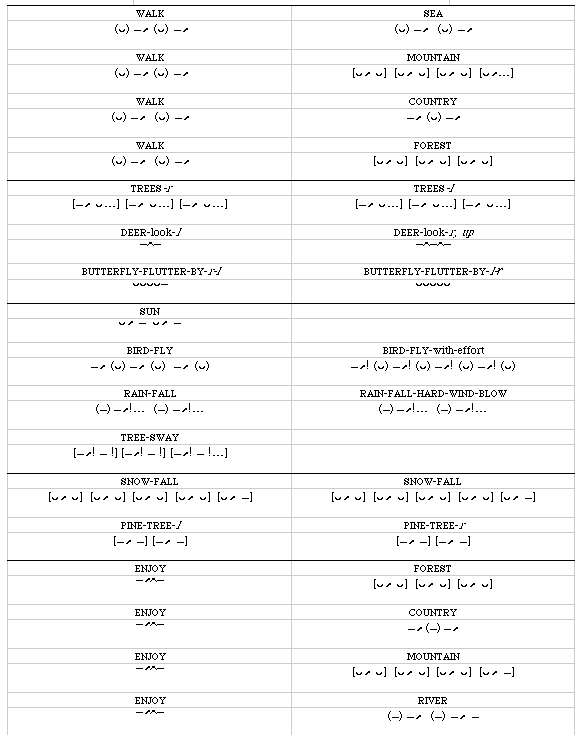
![]()
* We are grateful to Onno Crasborn, Els van der Kooij, Harry van der Hulst and Marja Blees for the questions they raise regarding the connections between poetry and phonology.(back to text)
1 See Bernard (1994), who presents Poésies d´un Sourd-Muet, published in 1844 by the deaf poet, Pierre Pelissier.(back to text)
2 See Padden and Humphries (1988: 73), who mention "old home movies" dating from 1940 to 1964, and records of social activities, including "performance, songs, skits, and lectures."(back to text)
3 See for instance Ormsby A. (1995): "Poetic cohesion in ASL. Valli´s ´Snowflake´ and Coleridge´s ´Frost at Midnight´," SLS 88: 227-244.(back to text)
4 After Klima, E. S. and Bellugi, U. (1975): "Wit and Poetry in American Sign Language," SLS 8: 203-224.(back to text)
5 The authors do not discuss their reasons for using the term ART-SIGN rather than POETRY. (back to text)
6 About Fant´s rendition of Miles´ poem " SUMMER " Klima and Bellugi (1976: 76) say that "He expresses ´depths´ of the English version not by a separate sign but rather by extending the sign GREEN in a wide sweep of the arm which gives the impression of the sign GREEN moving into the horizontal distance away from him ." (back to text)
7 Rachel Sutton-Spence (paper presented at TISLR´98 in Washington) gives the example of a Dorothy Miles creation: the invented sign TWIN-TREE, with a contact between the two elbows, which appears to violate normal rules of sign language structure. (back to text)
8 See Ormsby (p. 147) who seems to share this opinion. (back to text)
9 Ormsby (1995), in chapter three, examines the influence that English poetic tradition has had on deaf poets composing in ASL.(back to text)
10 We make a conscious distinction here between stress as a marker of linguistic structure, whether at the lexical or phrasal levels, and rhythmic accent as an element of (paralinguistic) rhythmic structure. Both stress and accent are realised via similar articulatory mechanisms, and both signal a contrast between a salient element and a less salient counterpart. The distinction that should be made is at the level of demarcative function. Stress functions as a means of marking off meaningful linguistic units, whether lexical or phrasal, or establishing contrasts of focus at the phrasal level and, in some languages, of establishing lexical contrasts between (segmentally) homophonous words. Rhythmic accent, on the other hand, typically has no demarcative linguistic function as such. It is a basic unit in metrical structure, where it contrasts with (relatively) unaccented elements of metrical structure. Metrically determined accent can affect the lexically specified stress or rhythmic structure of individual words to ensure an optimal metrical structure in a given context, as in the Rhythm Rule of English and other languages or in the imposition of repetition on metrically deficient signs in LSQ (Miller 1997). Both of these examples can be seen as instances in which a metrically determined alternation of accents is (locally) ranked higher in importance than lexically or syntactically determined demarcative stress. This subordination of stress to accent seems, however, to be the exception rather than the rule in normal uses of language. One of the defining characteristics that set poetry apart from prose is the fact that the metrically determined alternation between accented and unaccented elements is often elevated to the status of a primary consideration, with the result that very often unusual lexical choices are made, lexical stress and vowel length are violated and otherwise ungrammatical or atypical word orders appear, all in order to shoehorn the linguistic structure into the chosen rhythmic pattern. The virtuosity with which this task is accomplished is one of the marks of good versus bad poetry. (back to text)
11 We are grateful to Valérie Duhayer of the bilingual education program at the Institut Laurent Clerc in Torcy, France, for bringing this poem to our attention. (back to text)
12 We are grateful to Karine Feuillebois of the bilingual educational program at the Institut Laurent Clerc in Torcy, France, for bringing this poem to our attention.(back to text)
13 Indeed, the literature on linguistic variation makes it clear that the typical speaker-hearer (or in our case, signer) varies his or her linguistic behaviours, at all levels of structure, in relation to the sociolinguistic context and register. (back to text)
14 Sign language of the Netherlands (Nederlandse gebarentaal), Quebec Sign Language (Langue des signes québécoise) and French Sign Language (Langue des signes française). (back to text)
15 A somewhat similar phenomenon is sometimes encountered in music, where in a rhythmic piece the beat is suspended for the duration of a rhythmic measure while a purely melodic interval is played or sung, upon which the normal beat is again taken up. (back to text)
16 The diagnostics for emphasis in the relevant signs are (in comparison with the more neutral sign) the presence of extra speed and tension in the movement, coupled with added nonmanual (i.e. body and head) movements that reinforce and amplify the directionality and size of the manual movement. (back to text)
posted:31.01.2000